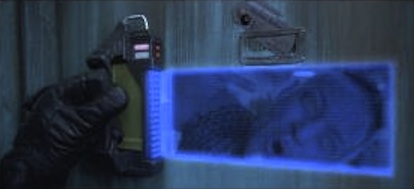Science Fiction
Dictionary
A B C D E F G H I J K L M N O P Q R S T U V W X Y Z
RF-Capture Lets MIT Boffins See Through Walls

RF-Capture works by sending out radio waves; when they strike an individual behind a wall, reflections come back to the device for analysis. RF-Capture measures the intensity of the return waves, among other variables, and then uses an algorithm to put together a rudimentary silhouette model of the personís body type.
(RF-Capture video)
We present RF-Capture, a system that captures the human figure Ė i.e., a coarse skeleton Ė through a wall. RF-Capture tracks the 3D positions of a personís limbs and body parts even when the person is fully occluded from its sensor, and does so without placing any markers on the subjectís body.In designing RF-Capture, we built on recent advances in wireless research, which have shown that certain radio frequency (RF) signals can traverse walls and re-flect off the human body, allowing for the detection of human motion through walls. In contrast to these past systems which abstract the entire human body as a single point and find the overall location of that point through walls, we show how we can reconstruct various human body parts and stitch them together to capture the human figure.
We built a prototype of RF-Capture and tested it on 15 subjects. Our results show that the system can capture a representative human figure through walls and use it to distinguish between various users.
SF movie fans may recall the device from the 1997 film The Fifth Element; police used a hand-held device to see through doorways in to apartments.

Fans of sf literature have of course enjoyed various versions of this technology for many years. Consider the Subphoton Search Ray from The Shining One (1937, Nat Schachner), the Probability Time Wave Tube from Elimination (1936, John W. Campbell) and the X-Beam Projector from Diamond Planetoid (1937, Gordon A. Giles).
If you're excited about seeing through walls (and who isn't?), take a look at Four Devices That see Through Walls.
Via BGR.
Scroll down for more stories in the same category. (Story submitted 10/23/2015)
Follow this kind of news @Technovelgy.| Email | RSS | Blog It | Stumble | del.icio.us | Digg | Reddit |
Would
you like to contribute a story tip?
It's easy:
Get the URL of the story, and the related sf author, and add
it here.
Comment/Join discussion ( 0 )
Related News Stories - (" Surveillance ")
India Ponders Always-On Smartphone Location Tracking
'It is necessary... for your own protection.' - Jack Vance, 1954.
LingYuan Vehicle Roof Drones Now Available, ala Blade Runner 2049
Accompanied by a small selection of similar ideas from science fiction.
Chameleon Personalized Privacy Protection Mask
'...the Virtual Epiphantic Identity Lustre.' - Neal Stephenson, 2019.
Spherical Police Robot Rolls In China
'Rand could effectively be in several places at once...' - Niven and Pournelle, 1981.
Technovelgy (that's tech-novel-gee!) is devoted to the creative science inventions and ideas of sf authors. Look for the Invention Category that interests you, the Glossary, the Invention Timeline, or see what's New.
Science Fiction
Timeline
1600-1899
1900-1939
1940's 1950's
1960's 1970's
1980's 1990's
2000's 2010's
Current News
Golf Ball Test Robot Wears Them Out
"The robot solemnly hit a ball against the wall, picked it up and teed it, hit it again, over and again...'
Boring Company Vegas Loop Like Asimov Said
'There was a wall ahead... It was riddled with holes that were the mouths of tunnels.'
Rigid Metallic Clothing From Science Fiction To You
'...support the interior human structure against Jupiterís pull.'
Is The Seattle Ultrasonics C-200 A Heinlein Vibroblade?
'It ain't a vibroblade. It's steel. Messy.'
Roborock Saros Z70 Is A Robot Vacuum With An Arm
'Anything larger than a BB shot it picked up and placed in a tray...'
A Beautiful Visualization Of Compact Food
'The German chemists have discovered how to supply the needed elements in compact, undiluted form...'
Bone-Building Drug Evenity Approved
'Compounds devised by the biochemists for the rapid building of bone...'
Secret Kill Switch Found In Yutong Buses
'The car faltered as the external command came to brake...'
Inmotion Electric Unicycle In Combat
'It is about the size and shape of a kitchen stool, gyro-stabilized...'
Grok Scores Best In Psychological Tests
'Try to find out how he ticks...'
PaXini Supersensitive Robot Fingers
'My fingers are not that sensitive...'
Congress Considers Automatic Emergency Braking, One Hundred Years Too Late
'The greatest problem of all was the elimination of the human element of braking together with its inevitable time lag.'
The Desert Ship Sailed In Imagination
'Across the ancient sea floor a dozen tall, blue-sailed Martian sand ships floated, like blue smoke.'
The Zapata Air Scooter Would Be Great In A Science Fiction Story
'Betty's slapdash style.'
Thermostabilized Wet Meat Product (NASA Prototype)
There are no orbiting Michelin stars. Yet.
Could Crystal Batteries Generate Power For Centuries?
'Power could be compressed thus into an inch-square cube of what looked like blue-white ice'
